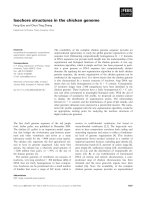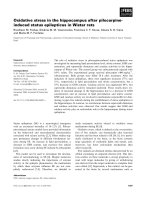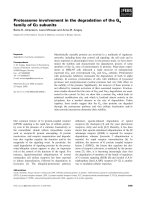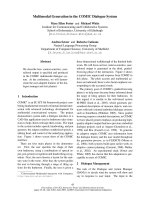Báo cáo khoa học: "AMBIGUITY RESOLUTION IN THE HUMAN SYNTACTIC PARSER: AN EXPERIMENTAL STUDY" ppt
Bạn đang xem bản rút gọn của tài liệu. Xem và tải ngay bản đầy đủ của tài liệu tại đây (428.58 KB, 5 trang )
AMBIGUITY RESOLUTION IN THE HUMAN SYNTACTIC PARSER: AN EXPERIMENTAL STUDY
Howard S. Kurtzman
Department of Psychology
Massachusetts Institute of Technology
Cambridge, MA 02139
(This paper presents in summary form some major
points of Chapter 3 of Kurtzman, 1984.)
Models of the human syntactic parsing mecha-
nism can be classified according to the ways in
which they operate upon ambiguous input. Each mode
of operation carries particular requirements con-
cerning such basic computational characteristics of
the parser as its storage capacities and the sched-
uling of its processes, and so specifying which
mode is actually embodied in human parsing is a
useful approach to determining the functional orga-
nization of the human parser. In Section l, a pre-
liminary taxonomy of parsing models is presented,
based upon a consideration of modes of handling
ambiguities; and then, in Section 2, psycholinguis-
tic evidence is presented which indicates what
type of model best describes the human parser.
I. Parsing Models
Parsing models can be initially classified ac-
cording to two basic binary features. One feature
is. whether the model immediately analyzes an ambi-
guity, i.e., determines structure for the ambiguous
portion of the string as soon as that portion be-
gins, or delays the analysis, i.e., determines
structure only after further material of the string
is received. The other feature is whether the model
constructs just a single analysis of the ambiguity
at one time, or instead constructs multiple anal-
yses in ~. The following account develops
and compITcates this initial classification scheme.
Not every type of model described here has actually
been proposed in the literature. The purpose here
is to outline the space of possibilities so that a
freer exploration and clearer evaluation of types
can be made.
An Immediate Single Analysis (ISA) model is
characterized by two properties: (1) An ambiguity
is resolved as soon as it arises, i.e., on its
first word (or morpheme); (2) the analysis that
serves as the resolution of the ambiguity is adopted
without consideration of any of the other possible
analyses. Typically, such models lack the capabili-
ty to store input material in a form which is not
completely analyzed. Pure top-down, depth-first
models such as classical ATN's (Woods, 1970) are
examples of ISA models.
For certain sentences, Frazier & Fodor's (1978)
Sausage Machine also behaves like an ISA model. In
explaining their Local Association principle, they
claim that in the first stage of parsing, structure
can be built for only a small number of words at a
time. As a result, in a sentence like "Rose read
the note, the memo and the letter to Mary," the PP
"to Mary" is immediately attached into a complex NP
with "the letter" without any consideration of the
other possible attachment directly into the VP, the
head of which ("read") is many words back.
A Dela_eZay_ed_Single ~ (DSA) model is also
characterized by two propertles: (1) When an ambi-
guity is reached, no analysis is attempted until a
certain amount of further input is received; and (2)
when an anlysis is attempted, then the analysis that
serves as the resolution of the ambiguity is adopted
without consideration of any other possible analyses
(if any others are still possible i.e., if the
string is still ambiguous). A bottom-up parser is
an example of a DSA model. Another example is Marcus's
(1980) Parsifal. These models must have some sort of
storage buffer for holding unanalyzed material.
It is possible for Single Analysis models to
combine Immediate and Delayed determination of
structure. Ford, Bresnan, & Kaplan's (1982) version
of a GSP does so in a limited way. Their Final Ar-
guments principle permits a delay in the determina-
tion of the attachment of particular constituents
into the overall structure of the sentence that has
been determined at certain points. (The GSP's Chart
is what stores the unattached constituents.) However,
it must be noted that during the period in which
that determination is delayed, other attachment pos-
sibilities of the constituent into higher-level
structures (which are themselves not yet attached
into the overall sentence structure) are considered.
Therefore, it is not the case in their model that
there is a true delay in attempting any analysis.
The fundamentally Immediate nature of the GSP re-
quires that some attachment possibility always be
tested immedi-ai-e-ly.
More authentic combinations of D- and ISA could
be constructed by modifying bottom-up parsers or
Parsifal, which are both inherently Delaying, so
that under certain conditions auxiliary procedures
are called which implement Immediate Analysis.
(There is, though, no real motivation at present for
such modifications.) It can be noted that while
bottom-up mechanisms are logically capable of only
Delayed Analysis, top-down mechanisms are capable of
either Immediate or Delayed Analysis.
Another type of model utilizes Delayed Parallel
Analysis (DPA). In this type, paralle-T-a-6aTysls ]-s 6-f~
an ambiguity is commenced only after some delay
481
beyond the beginning of the ambiguous portion of
the string. Such a model requires a buffer to hold
input material during the delay before it is anal-
yzed. Also, any model that allows parallelism re-
quires that the parser's representational/storage
medium be capable of supporting and distinguishing
between multiple analyses of the same input mater-
ial, and that the parser contain procedures that
eventually oversee a decision of which analysis is
to be adopted as resolution of the ambiguity. An
example of a DPA parser would be a generally
bottom-up parser which was adjusted so that at cer-
tain points, perhaps at the ends of sentences or
clauses, more than one analysis could be con-
structed. Another example would be a (serious)
modification of Parsifal such that when the pattern
of more than one production rule is matched, all of
those rules could be activated.
There are actually two sorts of parallelism.
One can be called momentary parallelism, in which a
choice is made among the possible analyses according
to some decision procedure immediately before the
next word is received. The other sort can be called
strong parallelism, in which the possible analyses
can stay active and be expanded as new input is
received. If further input is inconsistent with any
of the analyses, then that analysis is dropped.
There might also be a limitation on how long paral-
lel analyses can be held, with some decision pro-
cedure choosing from the remaining possibilities
once the limiting point is reached. (It would seem
that some limitation would be required in order to
account for garden-pathing.)
In addition, in strong parallelism although
multiple analyses are all available, they might
still be ranked in a preference order.
A further type of model is characterized by
Immediate Parallel Analysis (IPA), in which all of
the possib~ analyses of an ambiguity are built
as soon as the ambiguous portion of the string
begins. Frazier & Fodor's (1978) parser is par-
tially describable as an IPA model with momentary
parallelism. In explaining their Minimal Attachment
principle, they propose that an attempt is made to
build in parallel all the possible available struc-
tures, on the first word of an ambiguity. The par-
ticular structure that contains the fewest con-
necting nodes is the one that is then right away
adopted.
Fodor, Bever, & Garrett (1974) proposed an IPA
with strong parallelism. As soon as an ambiguity
arises, the possible analyses are determined in
parallel and can stay active until a clause boun-
dary is reached, at which point a decision among
them must be made.
There is another design characteristic that a
parser might have which has not been considered so
far. Instead of the parser, after making a single
or parallel analysis of an ambiguity, maintaining
the analysis/es as further input is received, one
can imagine it just dropping whatever analysis it
had determined. This can be called abandonment.
Then analysis would be resumed at some later point,
determined by some scheduling principles. Perhaps
the most natural form of a parser which utilizes
abandonment would be an IPA model. The construction
of more than one analysis for an ambiguity would
trigger the parser to throw out the analyses and
wait until a later point to attempt analysis anew.
Thus, the parser is not forced to make an early de-
cision which might turn out to be incorrect, as in
momentary parallelism, nor is it forced to carry
the load of multiple analyses, as in strong paral-
lelism. At an implementation level, this abandonment
might be realizedas mutual inhibition by the seve-
ral analyses.
Abandonment is also possible in an ISA model.
Take, for instance, a generally bottom-up model in
which constituents can be held free, not yet at-
tached into the overall sentence structure. A con-
straint could be plced on such a model which for-
bade such free constituents, forcing the analyses
of the constituents to be abandoned if they cannot
immediately be fit into the overall sentence struc-
ture. (Such a constraint might be implemented as a
limit on storage space for free constituents.)
Then, at some later point, a new analysis of the
constituents and their attachments would be made.
Abandonment is also possible, though less in-
tuitively satisfying, in delayed models. In these
models, there would be a delay in beginning analy-
sis, and then another delay as a result of abandon-
ment.
When analysis is begun again following aban-
donment, it can proceed according to any of the
above models, though of course some would seem to
be more natural than others.
2. Experiment
Previous psycholinguistic experiments have
often used quite indirect methods for tapping
parsing processes (e.g., Frazier & Rayner's (1982)
measurements of eye-movements during reading and
Chodorow's (1979) measurements of subjects' recall
of time-compressed speech) and have yielded con-
flicting results. The present investigation set out
to gather data concerning the determinants and
scheduling of ambiguity resolution, through use of
an on-line task that provides readily interpretable
results.
Subjects sat in front of a CRT screen and on
each trial were presented with a series of words
comprising a sentence, one word at a time, each
word in the center of the screen. Each word re-
mained on the screen for 240 msec and was followed
by a 60 msec blank screen. Presentation of the
words stopped at some point, either within or at
the end of the sentence, and a beep was heard. The
subjects' task was to respond, by pressing one of
two response keys, whether or not the sentence had
been completely grammatical up to that point.
For experimental items, presentation always
stopped before the end of the sentence, and the
sentence was always grammatical. These experimen-
tal sentences contained ambiguities which were
shown to be correctly resolved in only one way
by the last word that was presented. There were
482
two versions of each experimental item, which dif-
ferred only in the last presented word. And these
last words of the versions resolved the ambiguity in
different ways. An example is shown in (1) (along
with possible completions of the sentences in paren-
theses).
(1) The intelligent scientist examined with a
magnifier [a] our (leaves.)
[b] was (crazy.)
Any individual subject was presented with only one
version of an item. If subjects had chosen a par-
ticular resolution for the ambiguity before the last
word was presented, it was expected that they would
make more errors and/or show longer correct response
times (RTs) for the version which did not match the
resolution that they had chosen than for the version
which did match. (Experimental items were embedded
among a large number of filler items whose presenta-
tion stopped at a wide variety of points. Many of
these fillers also contained ungrammaticalities, of
various sorts and in various locations in the sen-
tence.)
A wide variety of ambiguities were tested, in-
cluding those investigated in previous studies. Only
a few highlights of the results are presented here,
in order simply to illustrate the major findings.
For items like (Ib), subjects made a large num-
ber of errors about 75%. This indicates that they
were garden-pathed just as in one's experience in
normal reading of such sentences. By contrast, for
items like (la), very few errors were made. Further,
the RTs for the correct responses to (la) were sig-
nificantly lower than those to (Ib). For (la), RTs
feIY in the 450-650 msec range, while for (Ib) the
RTs were lO0 to 400 msec higher. Evidently, subjects
had resolved the ambiguity in (1) before receiving
the last word, and they chose the resolution fitting
(la), in which "examined" is a main-clause past-
tense verb, rather than the resolution fitting (Ib),
in which it is a past participle of a reduced rela-
tive clause.
However, quite different results were obtained
for items like (2), which differs from (1) only by
the replacement of "scientist" by "alien".
(2) The intelligent alien examined with a
magnifier [a] our (leaves.)
[b] was (crazy.)
There was no difference between (2a) and (2b) in
either error rate or RT both measures fell into the
same low range as those for (la). That is, subjects
were not garden-pathed on either sentence. They kept
open both possibilities for analysis throughout
presentation of the sentence.
Several conclusions can be drawn from comparing
results of items like (1) and those like (2). First,
it is possible to delay the resolution of an analy-
sis. Two classes of parsing models can thus be ruled
out as descriptions of the overall operations of the
human system: ISA and IPA-with-momentary-parallelism.
Second, the duration of this delay is variable, and
therefore any model in which the point of resolution
for a particular syntactic structure is invariant
is ruled out. Marcus's Parsifal is an example of
such a disconfirmed model. By the way, this does not
mean that there must alw__~be some delay in resolu-
tion. In fact, for items like (1) it does appear
the resolution is made immediately upon reception
of "examined". This is indicated by subjects' per-
formance for (3) and (4) matching their performance
for (1) and (2), respectively.
(3) The intelligent scientist examined
[a] our (leaves.)
[b] was (crazy.)
(4)
The intelligent alien examined
[a] our (leaves.)
[b] was (crazy.)
It seems then that the delay can vary from zero to
evidently a quite substantial number of words (or
constituents).
Third, the duration of the delay is apparently
due to conceptual, or real-world knowledge, factors.
With regard to (1) and (2), one component of our
real-world knowledge is that scientists are likely
to examine something with a magnifier but unlikely
to be examined, but for aliens the likelihoods of
examining and being examined with a magnifier are
more alike. Thus, it seems that the point at which
a resolution is made is the point at which one of
the possible meanings of the sentence can be con-
fidently judged to be the more plausible one. So,
parsing decisions would be under significant influ-
ence of coneptual mechanisms. This fits with work
in Kurtzman (1984; Chapter 2), in which a substan-
tial amount of evidence is offered for the strong
claim that parsing strategies in the form of prefe-
rences for particular structures (e.g., Frazier &
Fodor, 1978; Ford et al., 1982; Crain & Steedman,
in press) do not exist. It is argued rather that
all cases of preference for one resolution of an
ambiguity over another can be accounted for by a
model in which conceptual mechanisms judge which
possible resolution of the ambiguity results in the
sentence expressing a meaning which better satis-
fies expectations for particular conceptual infor ~
mation or for general plausibility. Such a model
requires that parallel analyses be presented to the
conceptual mechanisms so that it may be judged
which analysis better meets the expectations.
Therefore, an acceptable parsing model must have
some parallel analysis at the time a resolution is
made (which is consistent with some previous psycho-
linguistic evidence: Lackner & Garrett, 1973). This
requirement of parallelism then leaves us with the
following models as candidates for describing the
human parser: DPA with either kind of parallelism,
IPA-with-strong-parallelism, or Abandonment-with-
parallel-reanalysis. (Abandonment might work in (2)
by abandoning analysis upon the attempt at analysis
of "examined" and then commencing re-analysis either
(a) at a point determined by some internal schedule,
or (b) upon a signal from conceptual mechanisms
that the conceptual content of the syntactically
unanalyzed words was great enough to support a con-
fident resolution decision.)
In contrast to the other remaining models,
483
IPA-with-strong-parallelism posits that input mate-
rial is at all times analyzed. A look at results
for other stimuli suggests that this might be the
case. In a task similar to the present one, Crain
& Steedman (in press) have shown that for items
such as (5), comprised of more than one sentence,
the first sentences (5a or 5b) can bias the per-
ceiver towards one or the other resolution in the
last sentence (5c or 5d), which contains an ambig-
uous "that"-clause (complement vs. relative).
(5a)
RELATIVE-BIASING CONTEXT
A psychologist was counseling two married
couples. One of the couples was fighting with
him but the other one was nice to him.
(5b)
COMPLEMENT-BIASING CONTEXT
A psychologist was counseling a married couple.
One member of the pair was fighting with him
but the other one was nice to him.
(5c)
RELATIVE SENTENCE
The psychologist told the wife that he was
having trouble with to leave her husband.
(5d)
COMPLEMENT SENTENCE
The psychologist told the wife that he was
having trouble with her husband.
So, for example, (5c) preceded by (Sa) is processed
smoothly, while (5c) preceded by (Sb) results in
garden-pathing at the point of disambiguation (the
word "to"). In the present experiment, sentences
in which the "that"-clause was disambiguated immedi-
ately following the beginning of the clause (5e
or 5f) were presented following the contexts of (5a)
or
(5b).
(Se) RELATIVE SENTENCE
The psychologist told the wife that
was (yelling to shut up.)
(Sf) COMPLEMENT SENTENCE
The psychologist told the wife that
to (yell was not constructive )
It turned out that context had no effect on perfor-
mance for this type of item. Rather, subjects per-
formed somewhat more poorly when the "that"-clause
was disambiguated as a relative (5e), showing about
20% errors and sometimes elevated RTs, as compared
with the complement disambiguation in (5f), which
showed low RTs and practically no errors. The effect
did not differ in strength between the two contexts.
These results along with those of Crain & Steedman
show that initially the complement resolution is
preferred but that later this preference can be
overturned in favor of the relative resolution if
that is what best fits the context. Now, there is
no reason to believe that subjects are actually
garden-pathed when they end up adopting the relative
resolution. Note that there is no conscious experi-
ence of garden-pathing, and that the error and RT
effects here are much weaker than for classical
garden-pathing items like (1). It seems more likely
that both possible analyses of "that" have been
determined but that one as a complementizer has
been initially ranked higher and so is initially
more accessible. In this speeded task, it would be
expected that the less accessible relative pronoun
analysis of "that" would sometimes be missed resul-
ting in incorrect responses for (5e) or take longer
to achieve. Now, if "that" had simply not been ana-
lyzed at all by the time of the presentation of the
last word, as in a DPA or Abandonment model, there
would be little reason to expect that one analysis
of it should cause more errors than the other.
So, we may tentatively conclude that IPA-with-
strong-parallelism describes the human parser's
operations for at least certain types of structures.
Similar results with other sorts of structures are
consistent with this claim. This does not rule out
the possibility, however, that the human parser is
a hybrid, utilizing delay or abandonment in some
other circumstances.
Why is the complementizer analysis immediately
preferred for "that"? In these items all of the
main verbs of the ambiguous sentences had meanings
which involved some notion of communication of a
message from one party to another (e.g., "told",
"taught", "reminded"). In Kurtzman (1984) it is
argued that such verbs generate strong expectations
for conceptual information about the nature of the
message that is communicated. The complement reso-
lution of the "that"-clause permits the clause to
directly express this expected information, and so
it would be preferred over the relative resolution,
which generally would not result in expression of
the information. It is also possible that such a
conceptually-based preference gets encoded as a
higher ranking for the verbs' particular lexical
representations which subcategorize for the com-
plement (cf. Ford et al., 1982).
REFERENCES
Chodorow, M.S. Time-compressed speech and the study
of lexical and syntactic processing. In W.E.
Cooper & E.C.T. Walker (Eds.), Sentence proces-
sing. Hillsdale, NJ: Erlbaum, l~
Crain, S. & Steedman, M. On not being led up the
garden path: The use of context by the psycho-
logical parser. In D. Dowty, L. Kartunnen, & A.
Zwicky (Eds.), Natural language processing. NY:
Cambridge Univers1~ress, in press.
Fodor, J.A., Bever, T.G., & Garrett, M.F. The psy-
chology o__f_flanguage. NY: McGraw-Hill, 1974.
Ford, M., Bresnan, J., & Kaplan, R.M. A competence-
based theory of syntactic closure. In J. Bresnan
(Ed.), The mental representation of grammatical
relation-s~. ~dge, MA: MIT Pre~, 1982.
Frazier, L. & Fodor, J.D. The sausage machine: A
new two-stage parsing model. Cognition, 1978, 6,
291-325.
Frazier, L. & Rayner, K. Making and correcting er-
rors during sentence comprehension: Eye movements
in the analysis of structurally ambiguous sen-
tences. Cognitive Psychology, 1982, 14, 178-210.
484
Kurtzman, H.S. Studies in syntactic ambiguity reso-
lution. Ph.D. Dissertation, MIT, 1984. (Available
from author in autumn, 1984, at School of Social
Sciences, Univ. of California, Irvine, CA 92664.)
Lackner, J.R. & Garrett, M.F. Resolving ambiguity:
Effects of biasing context in the unattended ear.
Cognition, 1973, I, 359-372.
Marcus, M. A theory o_f_f syntactic recognition for
natural language. Cambridge, MA: MIT Press, 1980.
Woods, W.A. Transition network grammars for natu-
ral language analysis. Communications of ACM,
1970, 13, 591-602.
485









